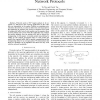Free Online Productivity Tools
i2Speak
i2Symbol
i2OCR
iTex2Img
iWeb2Print
iWeb2Shot
i2Type
iPdf2Split
iPdf2Merge
i2Bopomofo
i2Arabic
i2Style
i2Image
i2PDF
iLatex2Rtf
Sci2ools
100
click to vote
INFOCOM
2003
IEEE
2003
IEEE
Analysis on Packet Resequencing for Reliable Network Protocols
Abstract— Protocols such as TCP require packets to be accepted (i.e., delivered to the receiving application) in the order they are transmitted at the sender. Packets are sometimes misordered in the network. In order to deliver the arrived packets to the application in sequence, the receiver’s transport layer needs to temporarily buffer out-of-order packets and re-sequence them as more packets arrive. Even when the application can consume the packets infinitely fast, the packets may still be delayed for resequencing. In this paper, we model packet mis-ordering by adding an IID random propagation delay to each packet and analyze the required buffer size for packet resequencing and the resequencing delay for an average packet. We demonstrate that these two quantities can be significant and show how they scale with the network bandwidth.
Communications | INFOCOM 2003 | Out-of-order Packets | Receiver’s Transport Layer | TCP Require Packets |
Related Content
| Added | 04 Jul 2010 |
| Updated | 04 Jul 2010 |
| Type | Conference |
| Year | 2003 |
| Where | INFOCOM |
| Authors | Ye Xia, David N. C. Tse |
Comments (0)

